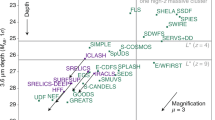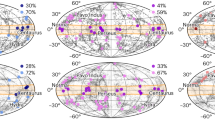Abstract
The Milky Way has at least twenty-three known satellite galaxies that shine with luminosities ranging from about a thousand to a billion times that of the Sun. Half of these galaxies were discovered1,2 in the past few years in the Sloan Digital Sky Survey, and they are among the least luminous galaxies in the known Universe. A determination of the mass of these galaxies provides a test of galaxy formation at the smallest scales3,4 and probes the nature of the dark matter that dominates the mass density of the Universe5. Here we use new measurements of the velocities of the stars in these galaxies6,7 to show that they are consistent with them having a common mass of about 107 within their central 300 parsecs. This result demonstrates that the faintest of the Milky Way satellites are the most dark-matter-dominated galaxies known, and could be a hint of a new scale in galaxy formation or a characteristic scale for the clustering of dark matter.
within their central 300 parsecs. This result demonstrates that the faintest of the Milky Way satellites are the most dark-matter-dominated galaxies known, and could be a hint of a new scale in galaxy formation or a characteristic scale for the clustering of dark matter.
This is a preview of subscription content, access via your institution
Access options
Subscribe to this journal
Receive 51 print issues and online access
$199.00 per year
only $3.90 per issue
Buy this article
- Purchase on Springer Link
- Instant access to full article PDF
Prices may be subject to local taxes which are calculated during checkout

Similar content being viewed by others
References
Willman, B. et al. A new Milky Way companion: unusual globular cluster or extreme dwarf satellite? Astron. J. 129, 2692–2700 (2005)
Belokurov, V. et al. Cats and dogs, hair and a hero: a quintet of new Milky Way companions. Astrophys. J. 654, 897–906 (2007)
Mateo, M. L. Dwarf galaxies of the Local Group. Annu. Rev. Astron. Astrophys. 36, 435–506 (1998)
Gilmore, G. et al. The observed properties of dark matter on small spatial scales. Astrophys. J. 663, 948–959 (2007)
Spergel, D. N. et al. Three-year Wilkinson Microwave Anisotropy Probe (WMAP) observations: implications for cosmology. Astrophys. J. 170, S377–S408 (2007)
Simon, J. D. & Geha, M. The kinematics of the ultra-faint Milky Way satellites: solving the missing satellite problem. Astrophys. J. 670, 313–331 (2007)
Walker, M. G. et al. Velocity dispersion profiles of seven dwarf spheroidal galaxies. Astrophys. J. 667, L53–L56 (2007)
Peebles, P. J. E. Large-scale background temperature and mass fluctuations due to scale invariant primeval perturbations. Astrophys. J. 263, L1–L5 (1982)
White, S. D. M., Frenk, C. S. & Davis, M. Clustering in a neutrino-dominated universe. Astrophys. J. 274, L1–L5 (1983)
Blumenthal, G. R., Faber, S. M., Primack, J. R. & Rees, M. J. Formation of galaxies and large-scale structure with cold dark matter. Nature 311, 517–525 (1984)
Klypin, A., Kravtsov, A. V., Valenzuela, O. & Prada, F. Where are the missing galactic satellites? Astrophys. J. 522, 82–92 (1999)
Moore, B. et al. Dark matter substructure within galactic halos. Astrophys. J. 524, L19–L22 (1999)
Diemand, J., Moore, B. & Stadel, J. Earth-mass dark matter haloes as the first structures in the early Universe. Nature 433, 389–391 (2005)
Diemand, J., Kuhlen, M. & Madau, P. Dark matter substructure and gamma-ray annihilation in the Milky Way halo. Astrophys. J. 657, 262–270 (2007)
Bode, P., Ostriker, J. P. & Turok, N. Halo formation in warm dark matter models. Astrophys. J. 556, 93–107 (2001)
Efstathiou, G. Suppressing the formation of dwarf galaxies via photoionization. Mon. Not. R. Astron. Soc. 256, 43P–47P (1992)
Kauffmann, G., White, S. D. M. & Guiderdoni, B. The formation and evolution of galaxies within merging dark matter haloes. Mon. Not. R. Astron. Soc. 264, 201–218 (1993)
Bullock, J. S., Kravtsov, A. V. & Weinberg, D. H. Reionization and the abundance of galactic satellites. Astrophys. J. 539, 517–521 (2000)
Kravtsov, A. V., Gnedin, O. Y. & Klypin, A. A. The tumultuous lives of galactic dwarfs and the missing satellites problem. Astrophys. J. 609, 482–497 (2004)
Mayer, L., Kazantzidis, S., Mastropietro, C. & Wadsley, J. Early gas stripping as the origin of the darkest galaxies in the Universe. Nature 445, 738–740 (2007)
Muñoz, R. R. et al. Exploring halo substructure with giant stars: the dynamics and metallicity of the dwarf spheroidal in Boötes. Astrophys. J. 650, L51–L54 (2006)
Martin, N. F., Ibata, R. A., Chapman, S. C., Irwin, M. & Lewis, G. F. A. Keck/DEIMOS spectroscopic survey of faint Galactic satellites: searching for the least massive dwarf galaxies. Mon. Not. R. Astron. Soc. 380, 281–300 (2007)
Strigari, L. E. et al. Redefining the missing satellites problem. Astrophys. J. 669, 676–683 (2007)
Mateo, M., Olszewski, E. W., Pryor, C., Welch, D. L. & Fischer, P. The Carina dwarf spheroidal galaxy: How dark is it? Astron. J. 105, 510–526 (1993)
Piatek, S. & Pryor, C. The effect of galactic tides on the apparent mass-to-light ratios in dwarf spheroidal galaxies. Astron. J. 109, 1071–1085 (1995)
Fellhauer, M. et al. Is Ursa Major II the progenitor of the orphan stream? Mon. Not. R. Astron. Soc. 375, 1171–1179 (2007)
Dunkley, J. et al. Five-year Wilkinson Microwave Anisotropy Probe (WMAP) observations: likelihoods and parameters from the WMAP data. Preprint available at 〈http://arxiv.org/abs/0803.0586〉 (2008)
Bullock, J. S. et al. Profiles of dark haloes: evolution, scatter and environment. Mon. Not. R. Astron. Soc. 321, 559–575 (2001)
Dekel, A. & Silk, J. The origin of dwarf galaxies, cold dark matter, and biased galaxy formation. Astrophys. J. 303, 39–55 (1986)
Wyithe, J. S. B. & Loeb, A. Suppression of dwarf galaxy formation by cosmic reionization. Nature 441, 322–324 (2006)
Martin, N. F., de Jong, J. T. A. & Rix, H.-W. A comprehensive maximum likelihood analysis of the structural properties of faint Milky Way satellites. Preprint at 〈http://arxiv.org/abs/0805.2945〉 (2008)
Acknowledgements
We thank K. Johnston and S. White for discussion on this paper, and J. Strader for help in the acquisition of data for the Willman 1 satellite.
Author information
Authors and Affiliations
Corresponding author
Supplementary information
Supplementary Information
The file contains Supplementary Discussion with additional references, Supplementary Table 1 and Supplementary Figures 1-2 with Legends. (PDF 487 kb)
PowerPoint slides
Rights and permissions
About this article
Cite this article
Strigari, L., Bullock, J., Kaplinghat, M. et al. A common mass scale for satellite galaxies of the Milky Way. Nature 454, 1096–1097 (2008). https://doi.org/10.1038/nature07222
Received:
Accepted:
Issue Date:
DOI: https://doi.org/10.1038/nature07222
This article is cited by
-
Stellar dynamics and dark matter in Local Group dwarf galaxies
Nature Astronomy (2022)
-
Galaxies with fuzzy dark matter
Journal of the Korean Physical Society (2021)
-
Further evidence for a population of dark-matter-deficient dwarf galaxies
Nature Astronomy (2019)
-
The distribution of dark matter in galaxies
The Astronomy and Astrophysics Review (2019)
-
Dark matter self-interactions from the internal dynamics of dwarf spheroidals
Nature Astronomy (2018)
Comments
By submitting a comment you agree to abide by our Terms and Community Guidelines. If you find something abusive or that does not comply with our terms or guidelines please flag it as inappropriate.



